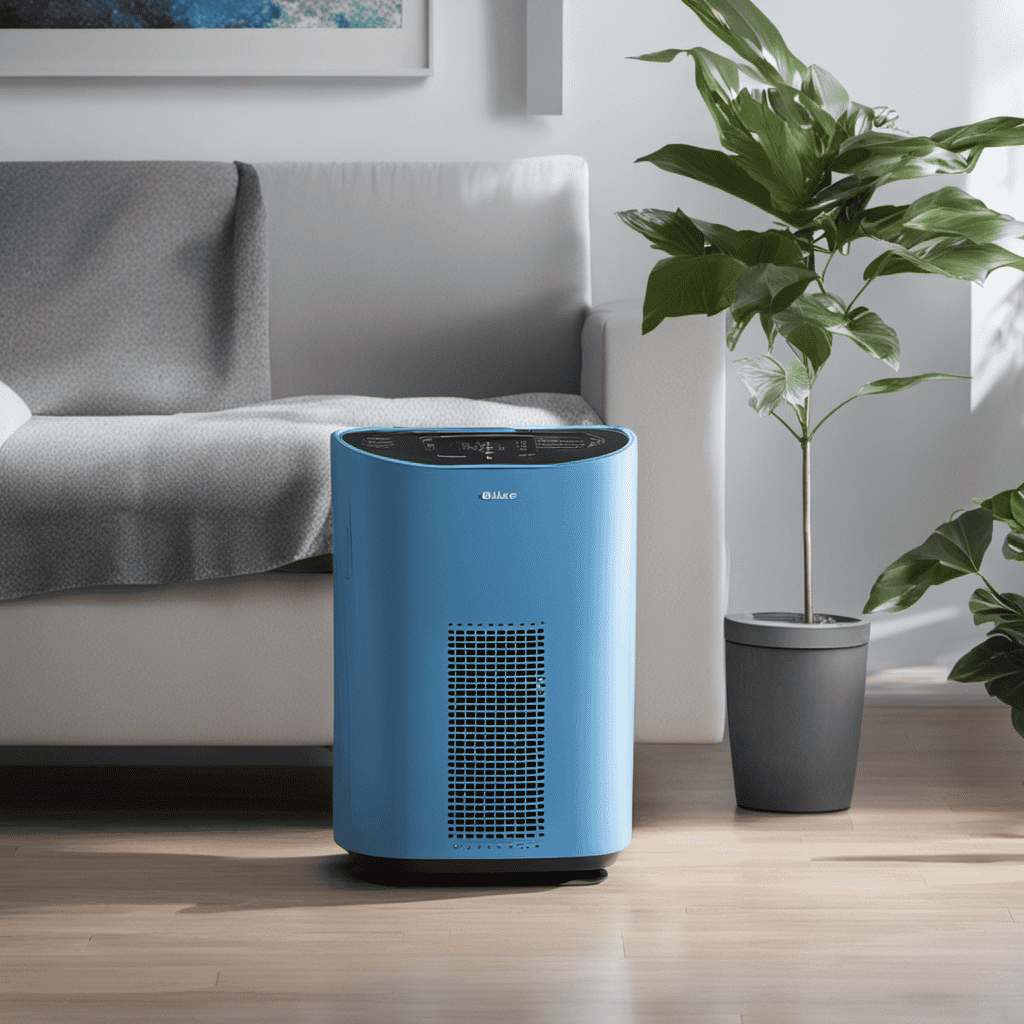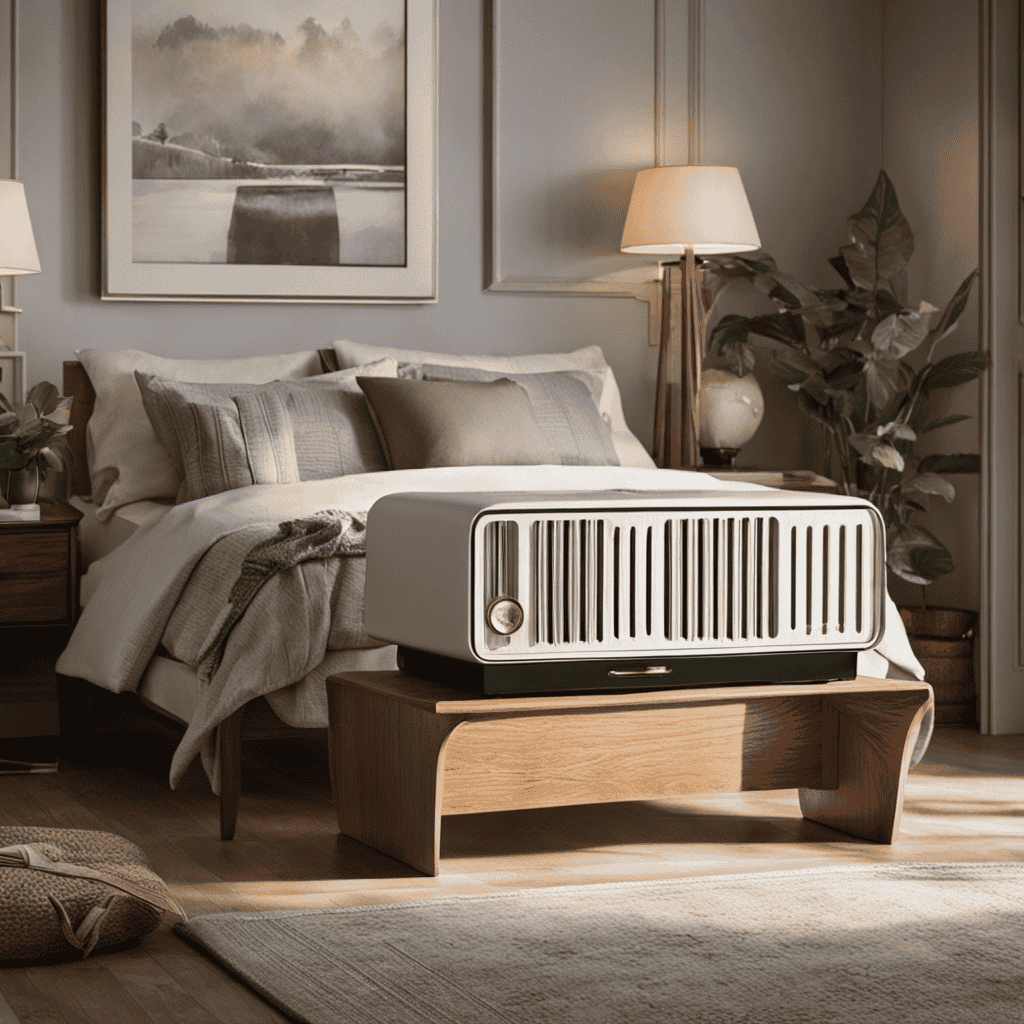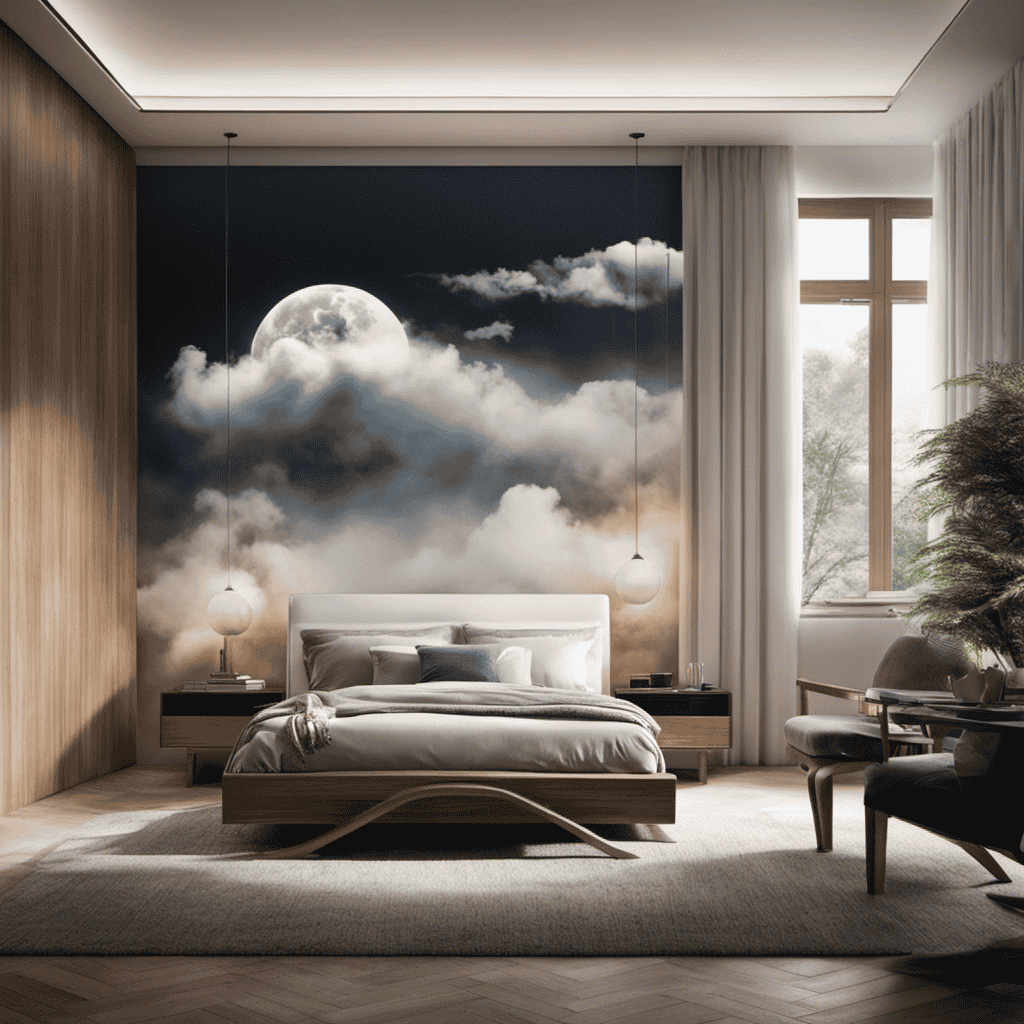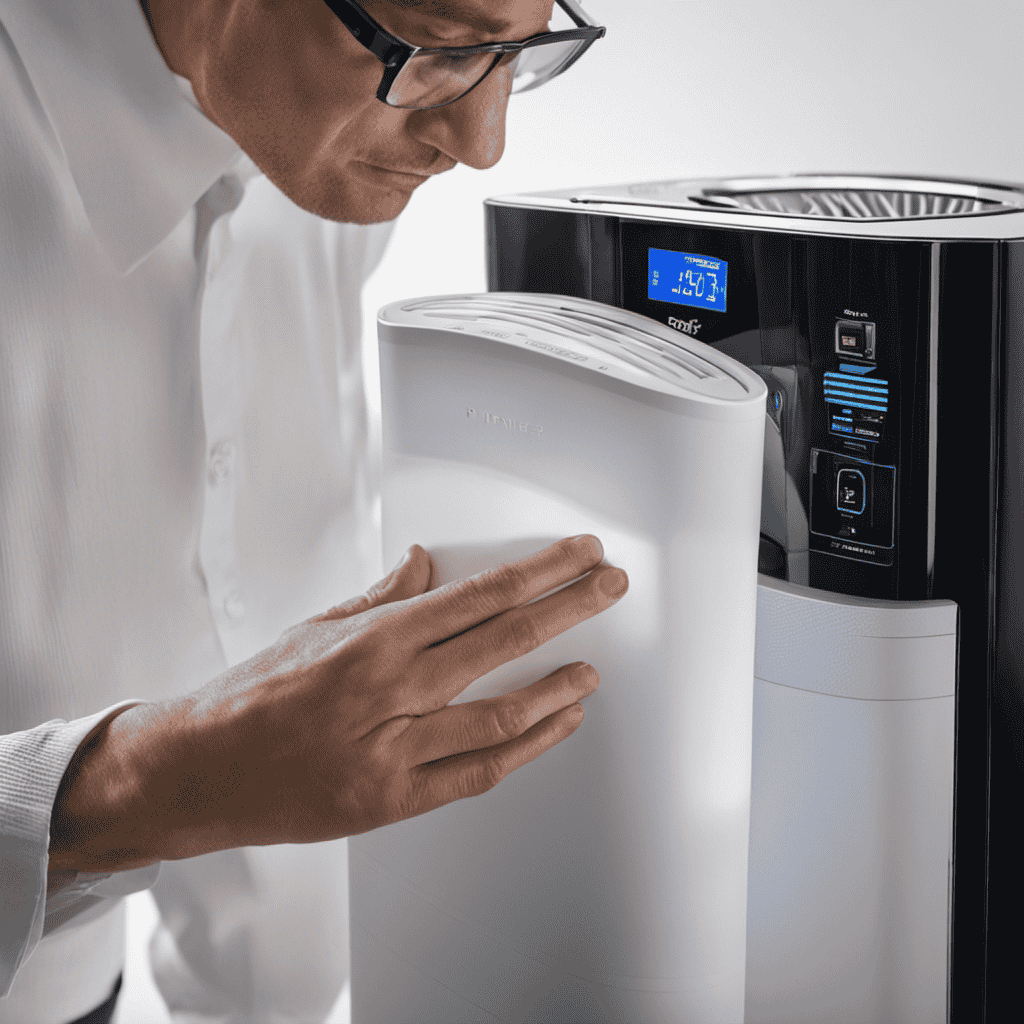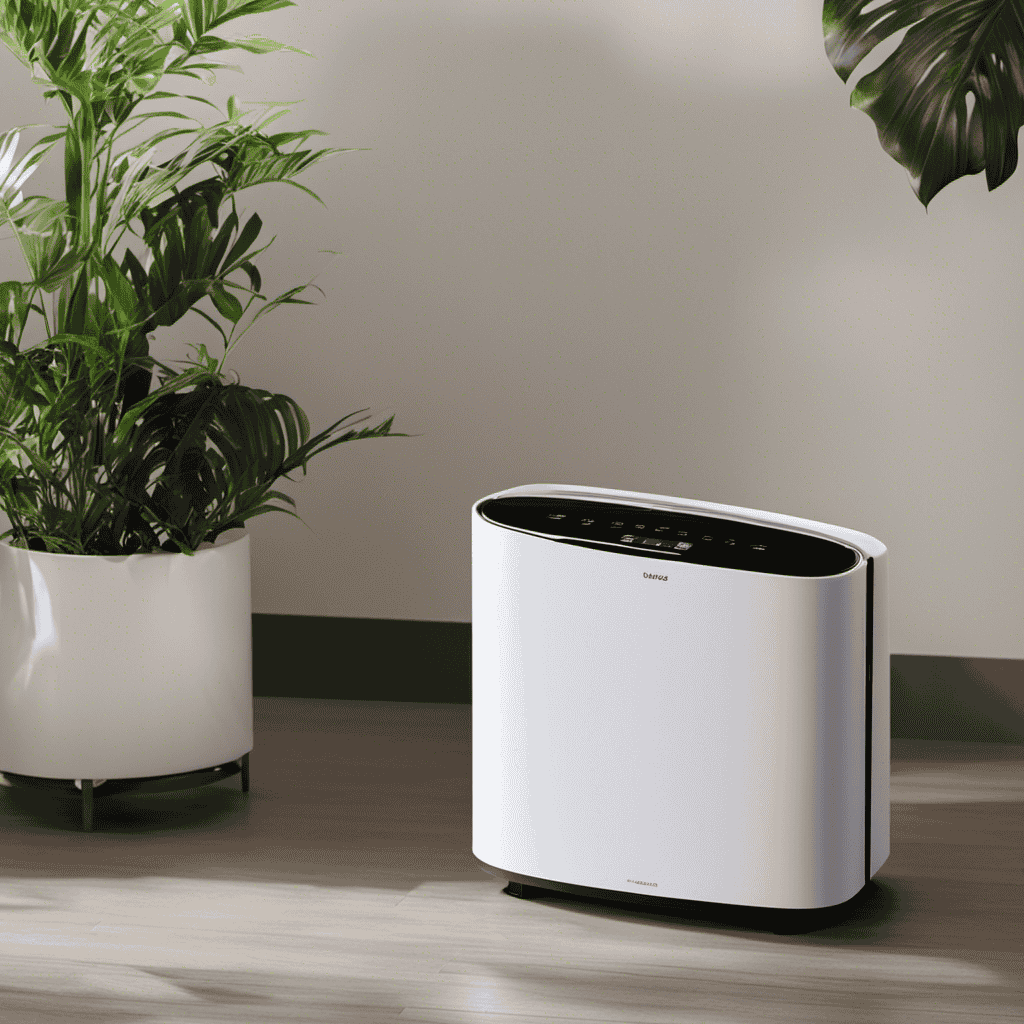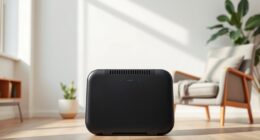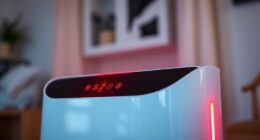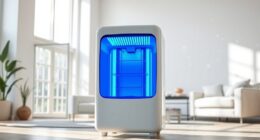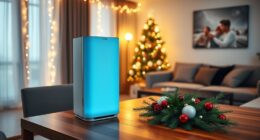I understand that changing the filter in a Blue Air Purifier may seem overwhelming. However, do not worry! This article will walk you through the simple process of replacing the filter in your Blue Air Purifier.
With a little bit of knowledge and the right tools, you’ll be able to keep your air purifier functioning at its best and ensure cleaner, fresher air in your home.
Let’s dive in and get started!
Key Takeaways
- Blue Air Purifier effectively removes pollutants from the air, alleviating symptoms and conditions associated with poor air quality.
- The Blue Air Purifier uses different types of filters, including HEPA filters and activated carbon filters, to capture and trap common air pollutants and eliminate unpleasant odors.
- Regularly checking the filter lifespan and monitoring performance is important to ensure optimal air purification efficiency.
- Proper filter changing technique, using the necessary tools and following manufacturer’s instructions, is crucial for efficient and effective filter replacement.
Understanding the Blue Air Purifier
The Blue Air Purifier is an effective device for removing pollutants from the air. It offers numerous benefits in improving indoor air quality and promoting a healthier environment.
One of the key advantages of the Blue Air Purifier is its ability to eliminate common air pollutants. These pollutants, such as dust, pollen, pet dander, and mold spores, can have detrimental effects on our health if left unaddressed. The Blue Air Purifier utilizes advanced filtration technology to capture and trap these pollutants, preventing them from circulating in the air we breathe.
The benefits of using the Blue Air Purifier are twofold. Firstly, it helps to alleviate symptoms and conditions associated with poor air quality, such as allergies, asthma, and respiratory issues. By removing airborne allergens and irritants, the Blue Air Purifier creates a cleaner and healthier environment, reducing the likelihood of experiencing these health problems.
Secondly, the Blue Air Purifier contributes to a more pleasant living space by eliminating unpleasant odors caused by smoke, cooking, and pets.
Types of Filters for the Blue Air Purifier
One popular option for the blue air purifier is a HEPA filter. HEPA stands for High Efficiency Particulate Air, and these filters are known for their ability to capture small particles from the air. They are made up of densely packed fibers that trap particles as they pass through the filter. HEPA filters are highly effective at removing allergens, such as pollen, pet dander, and dust mites, as well as fine particles like smoke and mold spores.
Another type of filter commonly used in blue air purifiers is the activated carbon filter. These filters are made from a type of charcoal that has been treated to increase its adsorption capacity. Activated carbon filters are excellent at removing odors, gases, and chemicals from the air. They work by trapping the molecules of these substances onto their porous surface.
Some blue air purifiers also come with a pre-filter, which is designed to capture larger particles like hair and lint. This helps to extend the lifespan of the main filter and improve the overall performance of the air purifier.
Assessing the Filter Lifespan
To determine how long the filters last, it is important to regularly check the manufacturer’s recommendations. The lifespan of a filter depends on various factors, such as the air quality in your surroundings and the frequency of use. Assessing the filter quality is crucial to ensure its effectiveness in purifying the air.
One way to assess the filter quality is by monitoring its performance over time. If you notice a decrease in air purification efficiency or an increase in dust and allergens in your environment, it may be a sign that the filter is reaching the end of its lifespan. Another indicator of a worn-out filter is a decrease in airflow. If you find that the air purifier is not circulating the air as effectively as before, it could be due to a clogged or deteriorated filter.
Inspecting the physical condition of the filter is also important. Look for signs of wear and tear, such as frayed edges or holes. If you see any visible damage, it is a clear indication that the filter needs to be replaced.
Remember to follow the manufacturer’s recommendations for filter replacement. Regularly assessing the filter quality and replacing it when necessary will ensure that your Blue Air Purifier continues to provide clean and fresh air for a healthier living environment.
Tools Required for Changing the Filter
When it comes to changing the filter in my blue air purifier, there are a few essential tools that I always make sure to have on hand. These tools include a screwdriver, a clean cloth, and a replacement filter.
Proper filter changing technique is also crucial to ensure optimal performance and air quality. By following the manufacturer’s instructions, I can confidently and efficiently replace the filter, improving the overall effectiveness of my air purifier.
Essential Filter Replacement Tools
You’ll need a few essential tools to replace the filter in your blue air purifier. Here are three items that will make the process easier:
-
Screwdriver: A screwdriver is necessary to remove the screws that hold the filter cover in place. Make sure to choose the right size for your particular air purifier model.
-
Replacement Filter: Of course, you’ll need a new filter to replace the old one. It’s important to choose a filter that is compatible with your blue air purifier model for optimal air quality.
-
Cleaning Cloth: Before installing the new filter, it’s a good idea to clean the inside of the air purifier. A soft cleaning cloth will help remove any dust or debris that may have accumulated.
Proper Filter Changing Technique
Before replacing the filter, it’s important to turn off the power and unplug the device.
Proper filter maintenance is crucial for the efficient functioning of your Blue Air Purifier. Here are some essential filter replacement tips to follow.
First, locate the filter compartment, typically located at the back or side of the purifier. Open the compartment and carefully remove the old filter. Dispose of it properly according to local regulations.
Next, unpack the new filter and insert it into the compartment, making sure it is securely in place. Close the compartment and ensure it is tightly sealed.
Finally, plug in the device and turn on the power. It’s recommended to check the manufacturer’s instructions for specific filter replacement intervals and further maintenance guidelines.
Following these steps will help maintain optimal air filtration in your Blue Air Purifier.
Step-by-Step Guide to Removing the Old Filter
First, make sure to unplug the blue air purifier before attempting to remove the old filter. This step is crucial to ensure your safety and prevent any potential electrical accidents.
Once the purifier is unplugged, follow these steps to successfully remove the old filter:
-
Locate the filter compartment: Depending on the model, the compartment may be on the side or at the back of the purifier. Refer to the user manual for specific instructions.
-
Open the compartment: Use the designated latch or button to open the compartment. Some models may require you to unscrew a panel. Take your time and be gentle to avoid damaging any components.
-
Remove the old filter: Carefully take out the old filter from its slot. It may be secured with clips or brackets, so be sure to release them before pulling the filter out. Dispose of the old filter properly according to local regulations.
Proper Disposal of the Used Filter
Now that we’ve successfully removed the old filter from the Blue Air Purifier, let’s discuss the proper disposal guidelines for this used filter.
Ensuring that we dispose of it correctly is important for maintaining a clean environment and minimizing potential harm to ourselves and the planet.
When it comes to the disposal of air purifier filters, there are a few eco-friendly options to consider.
One option is to check with your local recycling centers or waste management facilities to see if they accept used filters. Some recycling centers have specific guidelines for accepting and recycling air purifier filters.
Another eco-friendly option is to send the used filter back to the manufacturer. Many manufacturers provide recycling programs where you can return the used filter to them for proper disposal or recycling. This ensures that the materials in the filter are handled in an environmentally responsible manner.
If neither of these options is available, the next best approach is to seal the used filter in a plastic bag before disposing of it in your regular trash. This helps contain any potential contaminants within the filter and prevents them from spreading.
Selecting the Right Replacement Filter
When it comes to selecting the right replacement filter for your air purifier, there are three key points to consider: the filter compatibility guide, filter lifespan, and maintenance.
The filter compatibility guide will help you ensure that the replacement filter you choose is compatible with your specific air purifier model.
Understanding the filter lifespan is important as it will determine how often you need to replace the filter to maintain optimal air quality.
Additionally, proper maintenance of the filter, such as regular cleaning and replacement, is crucial for the effective functioning of your air purifier.
Filter Compatibility Guide
To determine which filters are compatible with the blue air purifier, check the filter compatibility guide. It is essential to ensure that the replacement filter is compatible with your specific model to maintain optimal performance.
Here are three filter replacement tips to keep in mind:
-
Model-specific compatibility: Each blue air purifier model requires a specific type of filter. Check the compatibility guide or the manufacturer’s website for a list of compatible filters for your specific model.
-
Filter dimensions: Pay attention to the dimensions of the replacement filter. It should match the size specifications of your blue air purifier to ensure a proper fit.
-
Filter type and performance: Consider your air quality needs and select a filter type that suits your requirements. Blue air purifiers offer various filter options, such as HEPA filters, activated carbon filters, or combination filters.
By following these filter replacement tips, you can ensure that your blue air purifier continues to effectively remove airborne pollutants.
Now, let’s explore the filter lifespan and maintenance to maximize the longevity of your purifier.
Filter Lifespan and Maintenance
Regular maintenance is crucial for maximizing the lifespan of your air purifier’s filter. To ensure optimal performance, it is essential to clean and replace the filter as recommended by the manufacturer.
Cleaning the filter should be done regularly to remove accumulated dirt and debris. This can be done by gently vacuuming or washing the filter with water and mild soap. However, it is important to check the manufacturer’s instructions as some filters may not be washable.
Additionally, it is necessary to follow a filter replacement schedule to ensure efficient air purification. Manufacturers usually recommend replacing the filter every 6 to 12 months, depending on usage and air quality.
Installing the New Filter in the Blue Air Purifier
Once you’ve obtained the new filter, simply slide it into place in the Blue Air Purifier. Installing the new filter is a straightforward process that requires minimal effort. Here are three techniques to ensure a successful filter replacement process:
-
Turn off the Blue Air Purifier: Before installing the new filter, it is crucial to switch off the purifier to prevent any accidents or damage to the device. Locate the power button and press it to turn off the unit.
-
Open the front panel: The Blue Air Purifier has a front panel that can be easily opened. Locate the latch or release button on the top or bottom of the panel and press or slide it to unlock the front cover. Gently lift the panel to expose the old filter.
-
Remove the old filter and insert the new one: Carefully remove the old filter by pulling it out of its place. Make sure to dispose of it properly. Take the new filter and slide it into the designated slot, ensuring that it fits snugly. Close the front panel by aligning the notches and pressing it firmly until it locks into place.
Once the new filter is installed, it is essential to test its functionality to ensure proper operation. This will be discussed in the subsequent section.
Testing the Functionality of the New Filter
After installing the new filter in the Blue Air Purifier, it is important to test its functionality to ensure that it is working effectively. There are several testing methods that can be used to evaluate the filter’s efficiency in removing airborne pollutants and improving indoor air quality.
One common testing method is the Particle Capture Efficiency Test. This involves introducing a known concentration of particles into the air and measuring the reduction in particle levels after the air passes through the filter. This test provides quantitative data on the filter’s ability to capture particles of various sizes.
Another testing method is the Odor Removal Test. This test involves introducing a specific odor into the air and measuring the reduction in odor intensity after the air passes through the filter. This test is particularly useful for filters that are designed to remove volatile organic compounds (VOCs) and other odorous substances.
To evaluate the overall performance of the filter, a Combination Test can be conducted. This test involves combining both the Particle Capture Efficiency Test and the Odor Removal Test to assess the filter’s ability to remove both particles and odors simultaneously.
Table:
| Testing Method | Description |
|---|---|
| Particle Capture Efficiency | Measures the reduction in particle levels after the air passes through the filter |
| Odor Removal | Measures the reduction in odor intensity after the air passes through the filter |
| Combination | Evaluates the filter’s ability to remove both particles and odors simultaneously |
Maintenance Tips to Extend Filter Lifespan
To prolong the lifespan of your filter, it’s important to regularly clean it according to the manufacturer’s instructions. Proper maintenance is crucial for ensuring the filter functions optimally and continues to provide clean air. Here are three essential filter maintenance techniques:
-
Regular Filter Cleaning: Cleaning your filter regularly is essential to remove accumulated dust, dirt, and other particles. Follow the manufacturer’s instructions for the recommended cleaning frequency. Generally, it involves gently vacuuming or rinsing the filter with water. Allow the filter to dry completely before reinstalling it.
-
Replacement Schedule: Filters have a limited lifespan and should be replaced as recommended by the manufacturer. Typically, this is every 6 to 12 months depending on usage and air quality. Regularly check the filter for signs of wear and tear, such as discoloration or damage, and replace it if necessary.
-
Air Purifier Placement: Proper placement of your air purifier can also help extend the lifespan of your filter. Keep it away from sources of dust and pollutants, such as open windows or smoking areas, to minimize the amount of particulate matter entering the filter. Additionally, avoid placing the purifier in a high-traffic area to prevent accidental damage.
Frequently Asked Questions
Can I Use a Third-Party Filter in the Blue Air Purifier?
Yes, it’s possible to use a third-party filter in the Blue Air Purifier. However, it’s important to consider the reliability and compatibility of the filter with the purifier.
Third-party filters may vary in quality and may not provide the same level of filtration as the original Blue Air filter. It’s recommended to check the specifications and reviews of the third-party filter before using it to ensure it meets the requirements of the Blue Air Purifier.
How Often Should I Clean or Replace the Pre-Filter?
Cleaning or replacing the pre-filter in the Blue Air Purifier is essential for maintaining optimal air quality. Regular maintenance ensures that the purifier functions efficiently and effectively.
However, determining how often to clean or replace the pre-filter depends on various factors, such as the level of pollutants in your environment and the usage of the purifier. It is advisable to consult the manufacturer’s guidelines or follow the recommended schedule provided with the purifier to ensure proper maintenance.
Is It Necessary to Unplug the Blue Air Purifier Before Changing the Filter?
Yes, it’s necessary to unplug the Blue Air Purifier before changing the filter. This precaution ensures safety and prevents any electrical accidents.
Unplugging the purifier disconnects it from the power source, reducing the risk of electric shock. Always remember to turn off the power and unplug the purifier before attempting to change the filter.
This simple step ensures a safe and hassle-free filter replacement process.
Can I Recycle the Used Filter?
Yes, you can recycle the used filter of the Blue Air Purifier. Recycling options for the filter may vary depending on your location.
It is important to consider the environmental impact of disposing of the filter properly. Recycling the filter helps reduce waste and promotes sustainability.
Contact your local recycling center or check with the manufacturer for specific instructions on how to recycle the used filter in an environmentally friendly manner.
What Should I Do if the New Filter Doesn’t Fit Properly in the Blue Air Purifier?
If the new filter doesn’t fit properly in the Blue Air Purifier, there could be a few reasons for this.
First, make sure you have the correct filter size for your specific purifier model. If you have the right size and it still doesn’t fit, try troubleshooting by checking for any obstructions or debris in the filter slot.
Additionally, double-check that you are inserting the filter correctly, following the manufacturer’s instructions.
Conclusion
In conclusion, changing the filter in the Blue Air Purifier is a simple and essential task for maintaining clean and healthy air in your home.
According to recent studies, indoor air can be up to five times more polluted than outdoor air. By regularly replacing the filter, you can significantly improve the air quality, reducing the risk of respiratory problems and allergies.
Following the step-by-step guide and implementing the maintenance tips will ensure the longevity and effectiveness of the filter, providing you with fresh and purified air for years to come.
